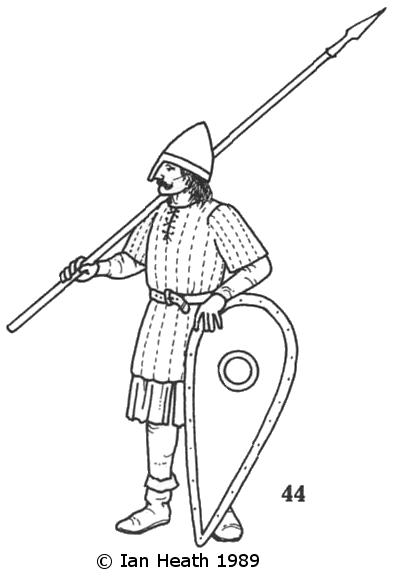
Create an Amazon Business Account
ENGLISH INFANTRYMAN OF HENRY II'S REIGN
 An extract from Armies of Feudal Europe 1066-1300
An extract from Armies of Feudal Europe 1066-1300by Ian Heath

 An extract from Armies of Feudal Europe 1066-1300
An extract from Armies of Feudal Europe 1066-130044. ENGLISH INFANTRYMAN OF HENRY II'S REIGN
By Henry II's 'Assize of Arms' of 1181 all - and only - freemen were to perform military service when required. They were divided for this purpose into 3 distinct categories: those holding knights' fiefs or possessing 16 marks of chattels or rents (who were to have the equipment of a knight); those possessing 10 marks of chattels or rents (who were to have haubergeon, helmet and spear); and burgesses and those freemen with less than 10 marks of chattels or rents. The man depicted is armed to comply with the requirements of the third category, who were expected to supply themselves with quilted wambais (gambeson), iron helmet and spear. A shield is not specified but was undoubtedly carried, as quite possibly was a sword or dagger, though one of the Assize's regulations stated that burgesses at least were forbidden to actually possess more than the obligatory quota of arms and had to sell or give away any in excess of their requirements. However, since neither swords nor daggers are specified for any of the categories - not even holders of knights fiefs - it must be assumed that by this time such weapons were normally available to most freemen and that therefore there was no need to mention them by name. Certainly contemporary illustrations from this period generally show swords in use amongst infantrymen of this type.
Despite the fact that archers had been much in evidence in both Henry I's reign (he issued an edict that men practicing archery should not be indicted for murder or manslaughter if they accidentally killed someone) and Stephen's reign (witness the prominent role of archers at the Battle of the Standard), bows are not mentioned at all in the Assize - regardless, too, of the fact that only a few days earlier the king had announced a similar assize for his Continental possessions wherein the bow is mentioned.* The only explanation that there can be for this is that in Henry II's reign the archers in English armies were generally supplied by Welsh mercenaries.
This edict similarly divided freemen up into 3 categories: those having chattels worth £100 Angevin (£25 sterling), who were to have the equipment of a knight, including a horse; those with chattels worth between £20-£40 Angevin (£5-£10 sterling), who were to have haubergeon, helmet spear and sword; and those with less, who were to have gambeson, helmet, spear and sword or bow and arrows.
[Based on Henry II's Assize of Arms]